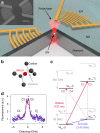Coherent acoustic control of a single silicon vacancy spin in diamond
- PMID: 31924759
- PMCID: PMC6954199
- DOI: 10.1038/s41467-019-13822-x
Coherent acoustic control of a single silicon vacancy spin in diamond
Abstract
Phonons are considered to be universal quantum transducers due to their ability to couple to a wide variety of quantum systems. Among these systems, solid-state point defect spins are known for being long-lived optically accessible quantum memories. Recently, it has been shown that inversion-symmetric defects in diamond, such as the negatively charged silicon vacancy center (SiV), feature spin qubits that are highly susceptible to strain. Here, we leverage this strain response to achieve coherent and low-power acoustic control of a single SiV spin, and perform acoustically driven Ramsey interferometry of a single spin. Our results demonstrate an efficient method of spin control for these systems, offering a path towards strong spin-phonon coupling and phonon-mediated hybrid quantum systems.
Conflict of interest statement
The authors declare no competing interests.
Figures




References
-
- Aspelmeyer M, Kippenberg TJ, Marquardt F. Cavity optomechanics. Rev. Mod. Phys. 2014;86:1391–1452. doi: 10.1103/RevModPhys.86.1391. - DOI
-
- Barfuss A, Teissier J, Neu E, Nunnenkamp A, Maletinsky P. Strong mechanical driving of a single electron spin. Nat. Phys. 2015;11:820–824. doi: 10.1038/nphys3411. - DOI
-
- Wallquist M, Hammerer K, Rabl P, Lukin M, Zoller P. Hybrid quantum devices and quantum engineering. Phys. Scr. 2009;T137:014001. doi: 10.1088/0031-8949/2009/T137/014001. - DOI
Grants and funding
- DMR-1231319/National Science Foundation (NSF)
- 1507508/National Science Foundation (NSF)
- N00014-15-1-2761/United States Department of Defense | United States Navy | Office of Naval Research (ONR)
- 5710004174/NSF | ENG/OAD | Division of Emerging Frontiers in Research and Innovation (EFRI)
- W911NF1520067/United States Department of Defense | United States Army | U.S. Army Research, Development and Engineering Command | Army Research Laboratory (U.S. Army Research Laboratory)
LinkOut - more resources
Full Text Sources
Other Literature Sources

